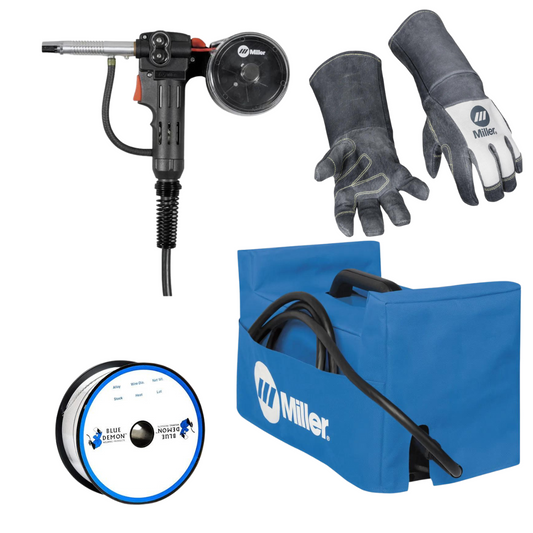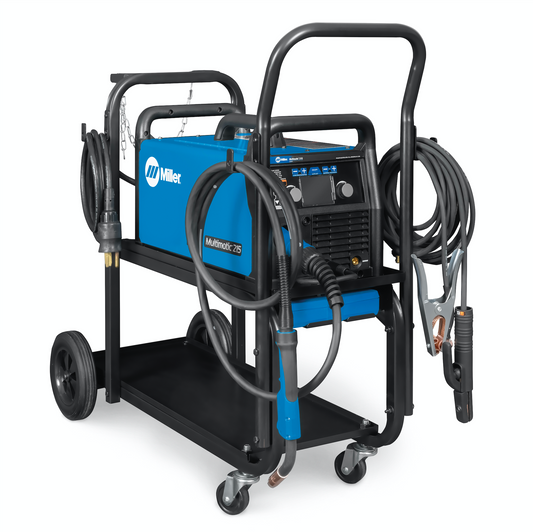Gases are an important part of MIG welding. In fact, they’re the source of the craft’s name: Metal Inert Gas welding. Technically speaking, inert gases are what make MIG welding what it is.
Why Inert Gases?
In short, the role of inert gases is to protect the weld from oxidation. Inert gases and gas mixtures, called “shielding gases” when used for MIG welding, are comprised of elements (in a gaseous state) that aren’t reactive to the elements in the welding wire or the metal(s) being welded. The shielding gas is pumped through the welding gun during welding. It comes through the tip of the gun, completely surrounding both the welding wire and the arc, thereby shielding them from the reactive elements in the air.
Specifically, shielding gases protect the wire electrode and base metals from oxygen, an element that is abundant in the air and problematic for welding. Oxygen is highly reactive with metals, especially commonly welded metals, and it’s even more reactive at the high heat generated by the welding process. When oxygen reacts with the base metals and/or the wire electrode, the resulting oxidation can form anything from a slight film or rusty discoloration to a porous, lumpy, ruined weld joint.
Common Shielding Gases
The four most common gases used in a shielding gas mixture are argon, helium, carbon dioxide, and (surprise!) oxygen. Each gas has its own use, and each comes with benefits and drawbacks for MIG welding, depending on the metals being welded.
Argon must be used without being combined with other elements when welding a non-ferrous (sometimes referred to as “exotic”) materials such as aluminum, magnesium, copper, and titanium. Otherwise, it is commonly mixed with a small portion of carbon dioxide. A mixture high in argon and low in carbon dioxide will often provide a good mixture of arc stability, reduced splatter, narrower penetration, and greater puddle control, all of which make this a potentially good gas mixture for welders looking for a more aesthetically pleasing weld joint that doesn’t require much cleanup.
Helium, like pure argon, is used with non-ferrous metals, as well as stainless steel. Its weld penetration is deep and wide, which makes it ideal for working with thicker materials. Helium is often combined with argon, and the ratio of helium to argon determines the thickness vs. thinness and the depth of the weld penetration. Helium produces a very hot weld, which makes for a relatively fast welding speed, but helium is also relatively expensive.
Carbon dioxide is a reactive gas – not an inert gas – and it is the only reactive gas that can be used for MIG welding without being mixed with at least one other inert gas. It provides a deep weld penetration, which is very useful when welding thicker materials, but it also produces a lot of spatter, requiring more cleanup. Pure carbon dioxide is the least expensive of the common shielding gases, making it a more attractive option for welders working with a tight budget.
Oxygen is, as previously discussed, also a reactive gas. When included in shielding gas mixtures, it’s a small percentage of the mixture. A small amount of oxygen in the gas mixture is beneficial only to certain types of base metals – carbon, low alloy, and stainless steel. In welds with these materials, oxygen can contribute to deeper weld penetration, arc stability, and puddle control. It will still contribute to oxidation in the weld, however, so it has limited applications and should not be used with more reactive metals.
Choosing the Right Shielding Gas
The decision about which shielding gas to use can be as easy or as complicated as the welder wants it to be. The easiest way to choose a shielding gas is to refer to the welding wire’s manufacturer recommendations. Additionally, many MIG welder manufacturers include helpful charts with their welders, and the internet is full of shielding gas selection charts as well. These charts can be a good starting point. Input from a welding supply store or an experienced welder can provide a more dynamic source of input.
Generally, charts and manufacturer recommendations will offer input based on the nature of the weld that the shielding gas options will provide. Cost, however, will likely play a part in discussions with other welders, and this can be an important factor in the decision process.


